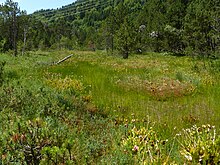Red pitcher plant
| Red pitcher plant | ||||||||||||
|---|---|---|---|---|---|---|---|---|---|---|---|---|

Red pitcher plant ( Sarracenia purpurea ) |
||||||||||||
| Systematics | ||||||||||||
|
||||||||||||
| Scientific name | ||||||||||||
| Sarracenia purpurea | ||||||||||||
| L. |
The red pitcher plant ( Sarracenia purpurea ) is a carnivorous plant from the pitcher plant family (Sarraceniaceae). It is widespread in North America from Canada to Florida .
Description and ecology
Vegetative characteristics
The red pitcher plant is considered to be the most original pitcher plant in phylogenetic terms. This also explains some of their special characteristics.
It catches its prey, which is mostly made up of insects , in hoses filled with rainwater. In contrast to other pitcher plants, it does not have a cover over the hose inlet, so it collects rainwater.
In contrast to its relatives, the red pitcher plant produces significantly fewer digestive enzymes and is therefore dependent on the help of bacterial cultures living in rainwater to dissolve its prey . Trapped insects are prevented from escaping downwardly directed hairs in the tubes, as well as the very smooth surface of the lower tube zone. Like all pitcher plants, it attracts its prey with sweet nectar and its attractive coloring. Despite the “simple” construction of the trap, it is very successful in catching prey. Since the tubes of the red pitcher plant are primarily oriented terrestrially, their prey spectrum consists more of ground-dwelling insects and other insects. A single tube can reach a length of 30 centimeters. The hoses do not die off over the winter.
The number of chromosomes is 2n = 26.
photos
Sarracenia purpurea with an umbrella-like, leaf-shaped stylus under the tips of which the hook-shaped scars sit
distribution
Sarracenia purpurea has the largest distribution area of all pitcher plant species. In the southern range (the south of New Jersey to the northeast of Florida) one finds the subspecies Sarracenia purpurea subsp. venosa (called Southern (Purple) Pitcher Plant in English ) - it forms thicker and more hairy tubes in comparison, this subspecies is only partially hardy .
The geographical separation of the subspecies is defined by the southernmost extent of the Pleistocene glaciation along northern Maryland and southern Delaware . While Sarracenia purpurea ssp. purpurea colonized the formerly glaciated regions, Sarracenia purpurea ssp. venosa on the then ice-free.
neophyte
In several cases, the red pitcher plant was anointed by plant lovers in suitable locations outside of its natural range . Some of these locations are naturalized, the oldest known in the Swiss Jura is around a hundred years old. In addition to this, anointings can also be found in Germany in Middle Franconia (thirty years old), in Lausitz (thirty years old), in North Rhine-Westphalia and in the Bavarian Forest . The deposits are considered vital, the plants reach sizes of up to 45 centimeters and a degree of coverage of up to 50%. Since the red pitcher plant competes with native moor species, it was placed on the black list of invasive species (early warning list) in Germany in 2013 . and removed during maintenance.
Further anointings can be found in Europe in Ireland, in the English Lake District , in Sweden and in the USA on the coast of California's Mendocino County .
Systematics
As early as 1601, Clusius , accompanied by the first illustration of the species and at the same time one of the earliest of a pitcher plant, described a red pitcher plant as Limonium peregrinum in his Rariorum plantarum historia , so incorrectly saw it as a sea lavender species. The first publication of Sarracenia purpurea was in 1753 by Carl von Linné .
Sarracenia rosea , which was separated from the red pitcher plant as an independent species in 2001 , is not universally accepted and is still considered to be a burkii variety of the venosa subspecies .
In the genus Sarracenia , Sarracenia purpurea is the most primitive species. Sarracenia purpurea subsp. venosa has a lighter flower (light red to red) than Sarracenia purpurea subsp. purpurea (dark red to purple red). The flower stem reaches a height of 20 to 40 centimeters. The flowering period begins from mid-March.
Depending on the author, there are subspecies, varieties and forms of Sarracenia purpurea :
-
Sarracenia purpurea
L. subsp. purpurea :
- Sarracenia purpurea subsp. purpurea f. heterophylla (Eaton) Fernald
-
Sarracenia purpurea subsp. venosa (Raf.) Wherry
-
Sarracenia purpurea subsp. venosa var. burkii D.E. Fast
- Sarracenia purpurea subsp. venosa var. burkii f. luteola Hanrahan & James M. Mill.
- Sarracenia purpurea subsp. venosa var. montana D.E. Schnell & Determann
-
Sarracenia purpurea subsp. venosa var. burkii D.E. Fast
Individual evidence
- ^ Sarracenia purpurea at Tropicos.org. In: IPCN Chromosome Reports . Missouri Botanical Garden, St. Louis
- ^ AM Ellison, HL Buckley, TE Miller and NJ Gotelli: Morphological variation in Sarracenia purpurea (Sarraceniaceae): geographic, environmental, and taxonomic correlates .. In: American Journal of Botany. Volume 91, Number 11, 2004, pp. 1930-1935, PMID 21652339 .
- ^ Daniel Lauterbach, Stefan Nehring: Nature Conservation Invasiveness Assessment Sarracenia purpurea - Brown-red pitcher plant created June 30, 2013. - Federal Agency for Nature Conservation, Bonn: 2 pp.
- ^ Bochum Botanical Association: Contributions to the flora of North Rhine-Westphalia from 2013. Yearbook of the Bochumer Botanical Association. Volume 5, 2014, pp. 130–163 ( PDF 6.4 MB)





